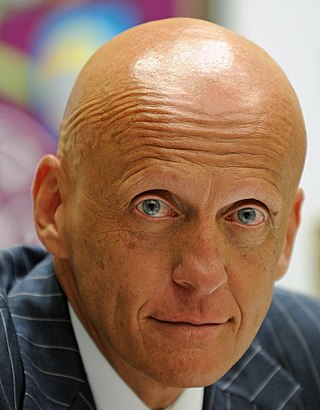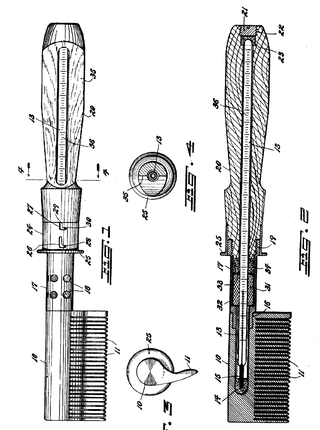Layer or layered may refer to:

Alopecia areata, also known as spot baldness, is a condition in which hair is lost from some or all areas of the body. It often results in a few bald spots on the scalp, each about the size of a coin. Psychological stress and illness are possible factors in bringing on alopecia areata in individuals at risk, but in most cases there is no obvious trigger. People are generally otherwise healthy. In a few cases, all the hair on the scalp is lost, or all body hair is lost. Hair loss can be permanent, or temporary.

Hair loss, also known as alopecia or baldness, refers to a loss of hair from part of the head or body. Typically at least the head is involved. The severity of hair loss can vary from a small area to the entire body. Inflammation or scarring is not usually present. Hair loss in some people causes psychological distress.

The hair follicle is an organ found in mammalian skin. It resides in the dermal layer of the skin and is made up of 20 different cell types, each with distinct functions. The hair follicle regulates hair growth via a complex interaction between hormones, neuropeptides, and immune cells. This complex interaction induces the hair follicle to produce different types of hair as seen on different parts of the body. For example, terminal hairs grow on the scalp and lanugo hairs are seen covering the bodies of fetuses in the uterus and in some newborn babies. The process of hair growth occurs in distinct sequential stages: anagen is the active growth phase, catagen is the regression of the hair follicle phase, telogen is the resting stage, exogen is the active shedding of hair phase and kenogen is the phase between the empty hair follicle and the growth of new hair.

Telogen effluvium is a scalp disorder characterized by the thinning or shedding of hair resulting from the early entry of hair in the telogen phase. It is in this phase that telogen hairs begin to shed at an increased rate, where normally the approximate rate of hair loss is 125 hairs per day.

Alopecia universalis(AU), also known as alopecia areata universalis, is a medical condition involving the loss of all body hair, including eyebrows, eyelashes, chest hair, armpit hair, and pubic hair. It is the most severe form of alopecia areata. People with the disease are usually healthy and have no other symptoms and a normal life expectancy.

Vellus hair is short, thin, light-colored, and barely noticeable hair that develops on most of a human's body during childhood. Exceptions include the lips, the back of the ear, the palm of the hand, the sole of the foot, some external genital areas, the navel, and scar tissue. The density of hair – the number of hair follicles per area of skin – varies from person to person. Each strand of vellus hair is usually less than 2 mm long and the follicle is not connected to a sebaceous gland.
Glabrousness is the technical term for a lack of hair, down, setae, trichomes or other such covering. A glabrous surface may be a natural characteristic of all or part of a plant or animal, or be due to loss because of a physical condition, such as alopecia universalis in humans, which causes hair to fall out or not regrow.

A hot comb is a metal comb that is used to straighten moderate or coarse hair and create a smoother hair texture. A hot comb is heated and used to straighten the hair from the roots. It can be placed directly on the source of heat or it may be electrically heated.
The management of hair loss, includes prevention and treatment of alopecia, baldness, and hair thinning, and regrowth of hair.

Locks of Love is a 501(c)(3) nonprofit charity that provides custom-made hair prosthetics to disadvantaged children up to the age of 21 who have suffered hair loss as a result of medical conditions, such as alopecia, burn trauma, and cancer treatment. They are provided to the children free of charge, and they may receive a new one every two years until they turn 21 years old. Locks of Love says that, despite rumors to the contrary, children and their families are never charged for the hair prosthetics they receive. Locks of Love accepts donations of human hair, and it also accepts financial donations.
A hair prosthesis is a custom-made wig specifically designed for patients who have lost their hair as a result of medical conditions or treatments, such as alopecia areata, alopecia totalis, trichotillomania, chemotherapy, or any other clinical disease or treatment resulting in hair loss. The terminology is used when applying for medical insurance or tax deduction status.
Follicular dysplasia is a genetic disease of dogs causing alopecia, also called hair loss. It is caused by hair follicles that are misfunctioning due to structural abnormality. There are several types, some affecting only certain breeds. Diagnosis is achieved through a biopsy, and treatment is rarely successful. Certain breeds, such as the Mexican Hairless Dog and Chinese Crested Dog, are bred specifically for alopecia.

Pattern hair loss is a hair loss condition that primarily affects the top and front of the scalp. In male-pattern hair loss (MPHL), the hair loss typically presents itself as either a receding front hairline, loss of hair on the crown (vertex) of the scalp, or a combination of both. Female-pattern hair loss (FPHL) typically presents as a diffuse thinning of the hair across the entire scalp.
Scarring hair loss, also known as cicatricial alopecia, is the loss of hair which is accompanied with scarring. This is in contrast to non scarring hair loss.
Non scarring hair loss, also known as noncicatricial alopecia is the loss of hair without any scarring being present. There is typically little inflammation and irritation, but hair loss is significant. This is in contrast to scarring hair loss during which hair follicles are replaced with scar tissue as a result of inflammation. Hair loss may be spread throughout the scalp (diffuse) or at certain spots (focal). The loss may be sudden or gradual with accompanying stress.
The growth of human hair occurs everywhere on the body except for the soles of the feet, the palms of the hands, the inside of the mouth, the lips, the backs of the ears, some external genital areas, the navel, and, apart from eyelashes, the eyelids. Hair is a stratified squamous keratinized epithelium made of multi-layered flat cells whose rope-like filaments provide structure and strength to the hair shaft. The protein called keratin makes up hair and stimulates hair growth. Hair follows a specific growth cycle with three distinct and concurrent phases: anagen, catagen, and telogen. Each phase has specific characteristics that determine the length of the hair.
Trauma most often refers to:
Toby Penty is a retired English badminton player. He started playing badminton at aged 9, and won U-19 English National Championships in 2011. In 2010, he won junior titles in the Netherlands and Switzerland. In 2017, he won the Swedish International tournament in the men's singles event.








